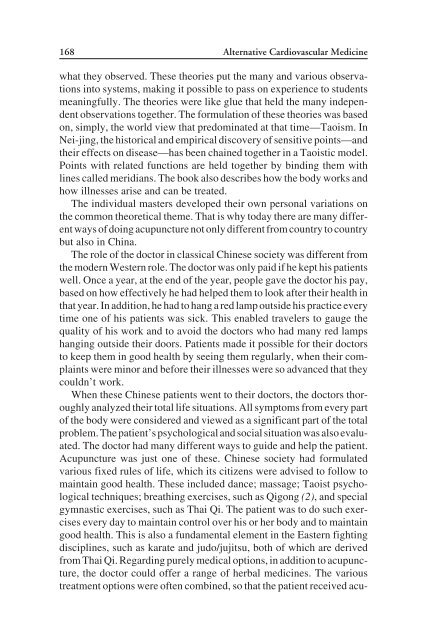Complementary Alternative Cardiovascular Medicine
Complementary Alternative Cardiovascular Medicine
Complementary Alternative Cardiovascular Medicine
Create successful ePaper yourself
Turn your PDF publications into a flip-book with our unique Google optimized e-Paper software.
168 <strong>Alternative</strong> <strong>Cardiovascular</strong> <strong>Medicine</strong><br />
what they observed. These theories put the many and various observations<br />
into systems, making it possible to pass on experience to students<br />
meaningfully. The theories were like glue that held the many independent<br />
observations together. The formulation of these theories was based<br />
on, simply, the world view that predominated at that time—Taoism. In<br />
Nei-jing, the historical and empirical discovery of sensitive points—and<br />
their effects on disease—has been chained together in a Taoistic model.<br />
Points with related functions are held together by binding them with<br />
lines called meridians. The book also describes how the body works and<br />
how illnesses arise and can be treated.<br />
The individual masters developed their own personal variations on<br />
the common theoretical theme. That is why today there are many different<br />
ways of doing acupuncture not only different from country to country<br />
but also in China.<br />
The role of the doctor in classical Chinese society was different from<br />
the modern Western role. The doctor was only paid if he kept his patients<br />
well. Once a year, at the end of the year, people gave the doctor his pay,<br />
based on how effectively he had helped them to look after their health in<br />
that year. In addition, he had to hang a red lamp outside his practice every<br />
time one of his patients was sick. This enabled travelers to gauge the<br />
quality of his work and to avoid the doctors who had many red lamps<br />
hanging outside their doors. Patients made it possible for their doctors<br />
to keep them in good health by seeing them regularly, when their complaints<br />
were minor and before their illnesses were so advanced that they<br />
couldn’t work.<br />
When these Chinese patients went to their doctors, the doctors thoroughly<br />
analyzed their total life situations. All symptoms from every part<br />
of the body were considered and viewed as a significant part of the total<br />
problem. The patient’s psychological and social situation was also evaluated.<br />
The doctor had many different ways to guide and help the patient.<br />
Acupuncture was just one of these. Chinese society had formulated<br />
various fixed rules of life, which its citizens were advised to follow to<br />
maintain good health. These included dance; massage; Taoist psychological<br />
techniques; breathing exercises, such as Qigong (2), and special<br />
gymnastic exercises, such as Thai Qi. The patient was to do such exercises<br />
every day to maintain control over his or her body and to maintain<br />
good health. This is also a fundamental element in the Eastern fighting<br />
disciplines, such as karate and judo/jujitsu, both of which are derived<br />
from Thai Qi. Regarding purely medical options, in addition to acupuncture,<br />
the doctor could offer a range of herbal medicines. The various<br />
treatment options were often combined, so that the patient received acu-


